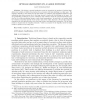Free Online Productivity Tools
i2Speak
i2Symbol
i2OCR
iTex2Img
iWeb2Print
iWeb2Shot
i2Type
iPdf2Split
iPdf2Merge
i2Bopomofo
i2Arabic
i2Style
i2Image
i2PDF
iLatex2Rtf
Sci2ools
SIAMAM
2008
2008
Optimal Liquidation by a Large Investor
Abstract. We develop a partial equilibrium model to investigate the problem of optimal liquidation over a finite or infinite time horizon for an investor with large holdings in a risky asset. The imperfect liquidity in the market for the asset leads to a nonlinear path dependent feedback on the underlying asset price process due to the large investor's trades and his holdings in the asset. We use probabilistic techniques to prove verification and existence results for optimal liquidation policies for the utility-maximizing investor under broad assumptions. In particular, our results imply the existence of optimal policies if the investor has power utility functions. We provide analytical expressions for the optimal policy when the large investor has logarithmic preferences. We use these results to characterize the "liquidity discount," which is a measure of the liquidity risk of the large investor's position in the risky asset. Key words. liquidation, large investor...
| Added | 14 Dec 2010 |
| Updated | 14 Dec 2010 |
| Type | Journal |
| Year | 2008 |
| Where | SIAMAM |
| Authors | Ajay Subramanian |
Comments (0)

